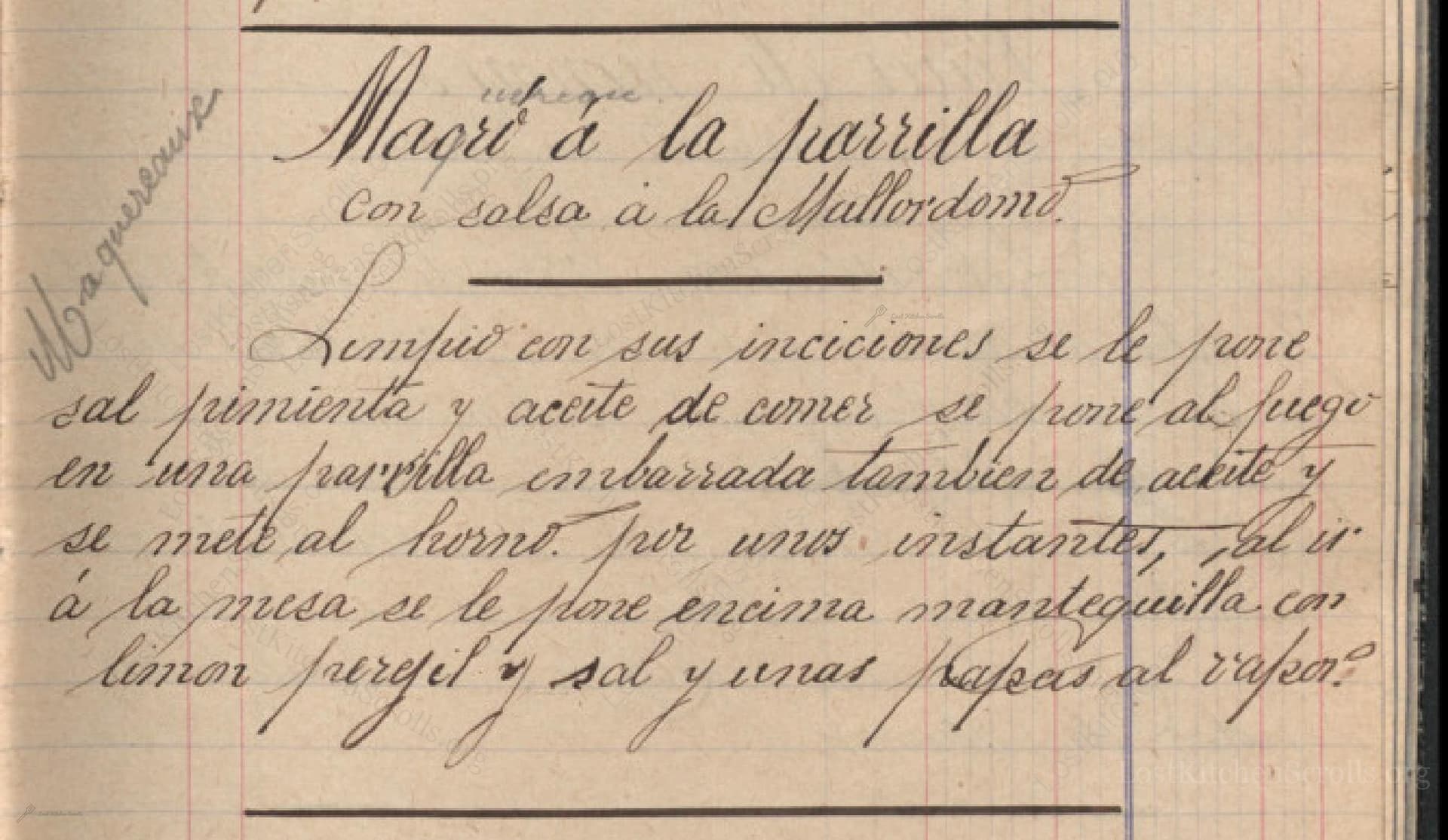Magré A La Parrilla Con Salsa A La Mallordomo
"Grilled Magré With Mallordomo Sauce"
From the treasured pages of Recetas de Cocina por Mi Profesor Sr. H. Winder
Written by Paulina Morante

Magré A La Parrilla Con Salsa A La Mallordomo
"Limpio con sus incisiones se le pone sal pimienta y aceite de comer se pone al fuego en una parrilla embarrada tambien de aceite y se mete al horno por unos instantes, al ir á la mesa se le pone encima mantequilla con limon peregil y sal y unas papas al vapor."
English Translation
"Cleaned with its incisions, it is seasoned with salt, pepper, and cooking oil. Place it over the fire on a grill also greased with oil and put it in the oven for a few moments. When serving, top it with butter mixed with lemon, parsley, and salt, along with some steamed potatoes."
Note on the Original Text
The original recipe is written in a succinct, almost telegraphic style, without standardized measurements or detailed timing—a common trait of early 20th-century manuscript cookbooks, which relied on the cook's experience and implicit knowledge. The language (‘aceite de comer’) refers generically to cooking oil, likely olive or local vegetable oil. The lack of precise instructions reflects both the expectation of culinary familiarity and the oral tradition from which such recipes derived, often hinting at European origin in spelling and vocabulary. Punctuation is sparse, and instructions flow in a single sentence—a peek into a more intuitive era of cooking.

Title
Recetas de Cocina por Mi Profesor Sr. H. Winder (1904)
You can also click the book image above to peruse the original tome
Writer
Paulina Morante
Era
1904
Publisher
Unknown
Background
Step into the flavorful world of early 20th-century cooking with Paulina Morante's delightful manuscript! This elegant collection features handwritten recipes and charming newspaper clippings, including specialties like pescado huachinango fresco and turrón de ciruela pasa. A true treasure for culinary adventurers.
Kindly made available by
University of Texas at San Antonio
This dish, 'Magré a la parrilla con salsa a la Mallordomo,' hails from an early 20th-century Mexican manuscript cookbook, penned in 1904 by Paulina Morante, under the guidance of Sr. H. Winder. The period reflects Mexico’s Porfiriato era, characterized by the blending of European culinary influences—here, French-inspired duck breast preparation—with local tastes and ingredients. The recipe showcases the increasing accessibility of techniques like grilling and oven finishing, as well as the use of butter, parsley, and lemon, all hallmarks of continental cooking introduced during this cosmopolitan period. Cookbooks of this period often bridged home and professional cooking, targeting skilled home cooks and aspiring bourgeois households.

At the turn of the 20th century, the kitchen would have featured cast-iron or wrought-iron grills, a wood- or coal-fired oven, and hand tools. A sturdy grilling grate or wire rack was oiled with a chunk of lard or cloth dipped in oil. Cooks used heavy knives for incisions, mortars for grinding spices, and basic metal tongs. The butter sauce would be mixed in a ceramic or tin bowl. Potatoes were steamed in a metal pot or steamer basket over the stove.
Prep Time
10 mins
Cook Time
15 mins
Servings
1
We've done our best to adapt this historical recipe for modern kitchens, but some details may still need refinement. We warmly welcome feedback from fellow cooks and culinary historians — your insights support the entire community!
Ingredients
- 1 duck breast (approximately 9–10.5 oz)
- Salt, to taste
- Freshly ground black pepper, to taste
- 1 tablespoon (0.5 fl oz) olive oil (substitute for generic 'aceite de comer')
- 1.5 tablespoons (0.7 oz) unsalted butter
- Juice of 1/2 lemon
- 1 tablespoon (0.14 oz) chopped fresh parsley
- Up to 7 oz small potatoes (for steaming)
Instructions
- Begin by cleaning a duck breast (magré), making shallow incisions on the skin.
- Season it generously with salt and freshly ground black pepper, then rub lightly with about 1 tablespoon of olive oil.
- Preheat a grill or grill pan, brushing it with oil to prevent sticking.
- Place the duck breast skin-side down on the hot grill, searing it to render the fat and achieve a golden crust.
- After a few minutes, quickly transfer the breast to a preheated oven (about 400°F) and roast for 5–8 minutes for medium-rare.
- As you prepare to serve, top the hot duck breast with a knob of butter mixed with lemon juice, chopped parsley, and a pinch of salt.
- Serve alongside steamed potatoes.
Estimated Calories
650 per serving
Cooking Estimates
You’ll spend a few minutes prepping the duck and potatoes, then the duck cooks quickly on the grill and finishes in the oven. Each serving, with the buttery herb topping and potatoes, is rich but balanced for a main meal.
As noted above, we have made our best effort to translate and adapt this historical recipe for modern kitchens, taking into account ingredients nowadays, cooking techniques, measurements, and so on. However, historical recipes often contain assumptions that require interpretation.
We'd love for anyone to help improve these adaptations. Community contributions are highly welcome. If you have suggestions, corrections, or cooking tips based on your experience with this recipe, please share them below.
Join the Discussion
Rate This Recipe
Dietary Preference
Main Ingredients
Occasions

Den Bockfisch In Einer Fleisch Suppen Zu Kochen
This recipe hails from a German manuscript cookbook compiled in 1696, a time whe...

Die Grieß Nudlen Zumachen
This recipe comes from a rather mysterious manuscript cookbook, penned anonymous...

Ein Boudain
This recipe comes from an anonymous German-language manuscript cookbook from 169...

Einen Schweinß Kopf Zu Kochen
This recipe hails from the 'Koch Puech', a lavish and encyclopedic German cookbo...
Browse our complete collection of time-honored recipes



